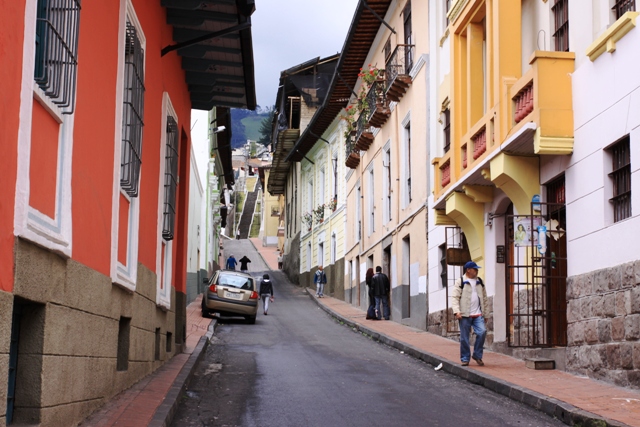Drilling for Oil in Eden: Initiative to Save Amazon Rainforest in Ecuador is Uncertain
Fate of the most biodiverse habitat in the western hemisphere in the hands of private citizens in US and Europe
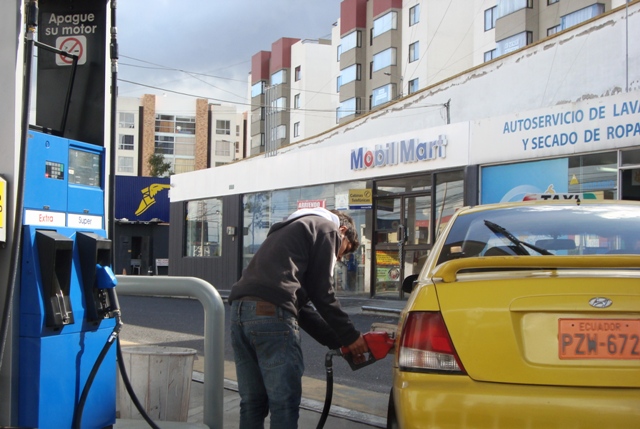
Pumping gasoline in Quito, Ecuador. Oil drilling threatens the Yasuní rainforest. Petroleum is Ecuador's primary source of income, but the country's reserves will be depleted in 15-20 years.
Quito, Ecuador— The most biologically diverse habitat in the western hemisphere, the Yasuní rainforest in Ecuador, is under threat. The diversity of species in the Yasuní Park is unmatched by any other park in the world. One hectare contains more species of trees than all of North America, but hidden beneath this Garden of Eden lies temptation: oil worth billions.
Ecuadorian president Rafael Correa is bargaining the fate of the Yasuní Park against the willingness of the industrialized world to pay 3.6 billion dollars in return for a promise not to extract oil from the ecological preserve. The conservation proposal is praised internationally as a c
reative way to protect the Amazon rainforest and the indigenous people living there, but the fate of the Yasuní Initiative is in doubt. There is uncertainty whether the funding can be raised as governments grapple with the international economic crisis, and skeptics question whether the bargain could work.
“They are going to drill. They are going to drill,” an authority on the Yasuní project told me in confidence. “Per
haps ten years from now, perhaps 5 years from now. The next president will need that money.”
Oil is Ecuador’s top export, providing one third of its revenue, but despite the black gold pooled beneath its steamy jungles, Ecuador is a poor country. With little industry, Ecuador’s 58.9 billion GDP is among the smallest in Latin America. (By comparison, the GDP of the USA is 14,600 billion.) Exporting raw materials, primarily petroleum, bananas, and shrimp, has enriched foreign corporations, but the wealth has not trickled down to the people. 50 % of Ecuadorian citizens live below the poverty level. One third of the children in Ecuador are malnourished and 60 % in the indigenous populations according to Health Minister, Carina Vance. Between 1999 and 2000 one million Ecuadorians fled their homeland to escape the misery
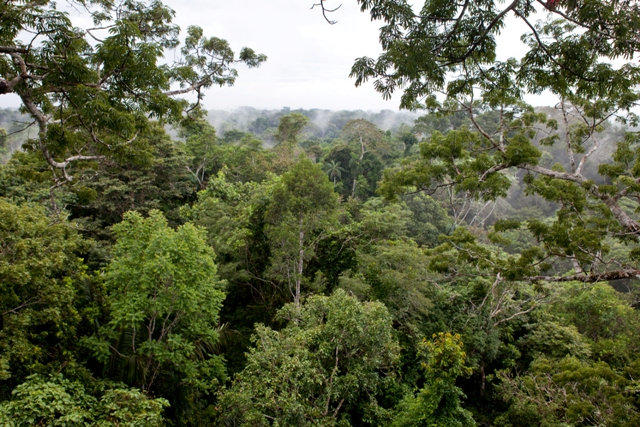
The Yasuní Park contains more species of trees in one hectare than in all of North America. Ecuador lost 4 million hectares of forest in the last 20 years—30 % of its total forest area. Courtesy UASB (Universidad Andina Simón Bolívar)
and financial collapse that left the country’s currency worthless. The US dollar is now the accepted currency.
“At some point conservation and ecology are kind of a luxurious thing. People have to eat,” says Prof. Hugo Navarrete, a Biologist at the Pontifica Universidad Católica del Ecuador, describing the situation from the point of view of those who would benefit from drilling.
Poverty and development are wreaking ecological havoc throughout the small country, which is blessed with an astonishing range of rich habitats from the lush Amazon jungle, and the high Andes Mountains, to the Pacific Coast including the Galápagos Islands, world renowned as a biological treasure. Shrimp farmers have contributed to the destruction of more than 65 percent of Ecuador’s mangrove habitat to build aquaculture ponds. The mangrove ecosystem cannot fully recover for more than 100 years after being cut. Waste water tainted with chemicals and antibiotics from the farms and pesticide runoff from fumigating banana plantations pollute water sources. An estimated 300,000 sharks are killed per year in Ecuadorian waters, when the taking of shark fins is condemned in most countries.
“The president cares about the money, not conservation. Conservation is not his top concern now. Economic output is his priority,” says an Ecuadorian graduate student, who asked not to be identified.
Elected in 2006, Socialist Rafael Correa pushed through a new constitution (the 20th in this turbulent country since 1830) giving the government great power over the legislature, judiciary and economy. Following the example of his avowed comrade, Hugo Chavez of Venezuela, Correa instituted state control of the independent press. Libel that offends the President caries a prison sentence of up to two years. Journalists have been arrested, including those reporting on environmental issues. Relations between the US and Ecuadorian governments have chilled as Correa is severing ties with North America and strengthening them with South American countries and US adversaries, most notably President Mahmoud Ahmadinejad in Iran. Yet the country has not succumbed to the violent drug gangs and Marxist guerillas roiling its neighbors, but crime, corruption and border disputes are persistent threats to stability in Ecuador. What assurance, some worry, is there that a troubled country that has reneged on its financial commitments in the past would not simply take the money from the Yasuní Initiative and drill for oil anyway?
Bad blood between Ecuador and US oil companies stems from environmental disasters caused by past oil drilling in the Amazon. Texaco (now a part of Chevron) is still in litigation over oil drilling in Ecuador beginning in 1964. Indians and settlers allege that the documented high rates of cancer and miscarriages that they are suffering are direct results of the intentional dumping of 68 million liters of crude oil into the rainforest—30 times more oil than was spilled in the Exxon Valdez disaster in 1989.
It’s not just the oil
“The question of conservation in Yasuní is not as simple as saying we are not going to drill…oil is not the problem.” Navarrete notes that there is no oil in the eastern side of the park “and almost everything is devastated.” The destruction of the forest there is caused by expansion for banana and oil palm plantations, pasturelands, road building, settlements, and illegal hunting and logging. The destruction is amplified as indigenous people become less isolated and acquire chain saws and other modern technology that are incompatible with their ancient nomadic way of life. The new taste for modern commodities, clothes, shoes, and mechanized equipment, creates a new demand for money, setting up a vicious cycle of harvesting the forest to sell for currency. “If you want to preserve this pristine forest you definitely have to solve the poverty problem.”
Sitting at his desk in Quito, Professor Carlos Larrea, an “Ecological Economist” at the Universidad Andina, Simón Bolívar, scratches out mathematical calculations using matrix algebra to model ecological and economic dynamics. “It is an unusual mix”, he says explaining his unique professional expertise, but by definition conservation lives at the intersection of science and politics. “The Initiative began with scientists,” he says, and Larrea has been a leader in the effort since the beginning.
“Ecuador has the largest undisturbed ecological system in South America. 20% of Ecuadorian land is protected. In spite of everything, the deforestation rate is the second highest in South America,” Larrea says. “This is why we need to stop deforestation not only in the park, but on a national level.”
With pride Larrea says that recently there has been a major achievement in efforts to save the Yasuní. On December 20, 2011, Ivonne Baki, representative for the Yasuní Initiative announced that President Rafael Correa decided to continue the Initiative though 2013 rather than begin drilling for oil, the so called “Plan B”, which is being plotted in parallel should the Initiative fail. The decision came after reaching the goal of obtaining 100 million dollars in pledge money from foreign countries by the end of the year. Next year, however, the ante raises to 291 million to forestall drilling. But will the developed world pony up?
“Pie in the sky—it will never happen,” a geologist and oil company executive predicted. “American oil companies know how to extract the oil in an environmentally safe manner, and the income would lift the people of Ecuador out of poverty.”
Safe Drilling?
The environmental standards and technology for oil extraction have advanced greatly in 50 years since Texaco drilled and spilled oil in the Amazon jungle. For example, the HRT Oil Company, in alliance with Russia’s TNK-BP and the state-run Petrobras, are drilling for oil in virgin rainforest in Brazil. The corporations use helicopters to fly workers and drilling equipment to the sites instead of cutting roads, and they lay flexible oil pipelines to circumnavigate sensitive vegetation.
“I think it is very risky.” Larrea cites the example of British Petroleum’s disastrous spill in the Gulf of Mexico. “It took more than 4-6 months just to cap it. BP has the best technology and standards in the industry, and they had an accident they never thought was even possible, which produced the largest oil spill in American history.”
Moreover, Larrea says that the unique geology in the Yasuní presents unique problems for oil extraction because of the large volume of water (95% or more) that is extracted with the oil. In regions adjoining the park the water pollution associated with oil extraction is a serious problem. “The environmental risk is too high.”
“Can’t live in the past”
Many feel that preserving the way of life of the indigenous people in the Amazon is as important as preserving the native plants and animals there, but in fact, this is part of the problem in the multifaceted challenge of preserving the Yasuní. “It is very romantic,” Navarrete admits, to imagine the Indians living harmoniously with nature in the Yasuní Forest, “but it is impossible to continue with that way of living.” He asks whether it is right to deny the Indians, who suffer a 50% infant mortality rate, access to immunization and modern medicine? But “If they take the medicine, their culture dies,” Navarrete says, because it undermines their traditional culture of reliance on Shamans and natural remedies. Moreover, the humane benefits of medicine increase deforestation because lowering the death rate increases pressure on the rainforest, by upsetting a centuries-old balance between the needs and practices of a small number of nomadic tribes harvesting game and using slash-and-burn farming to survive in the jungle. “In
the past they died of horrible diseases and only lived about 40 years, but now they can live to their 70’s.
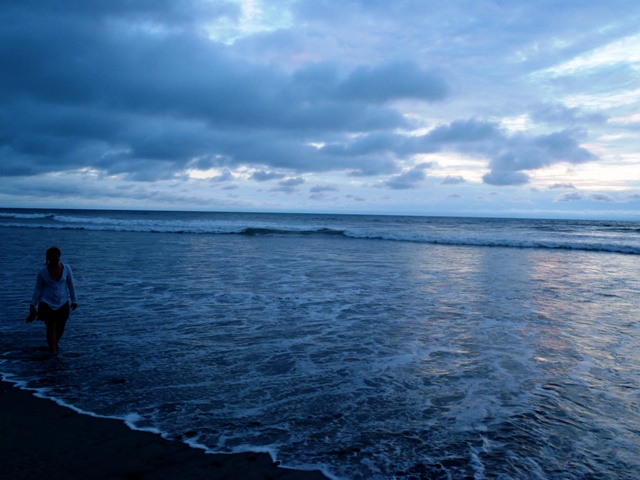
Compounding its biodiverse Amazon jungles, Ecuador is also blessed with 2,237 kilometers of Pacific coastline and the treasured Galápagos Islands. 65 % of the coastal mangroves in Ecuador have been destroyed for shrimp farming. The lost ecosystem provides critical habitat for birds and fish. Courtesy Clay Meier.
The problems developing countries are now struggling with are the same ones that industrialized countries faced over a century ago. “It is very important to learn from the past not only in the USA but Argentina, to avoid the mistakes of the past,” says Navarrete. Virgin forests are scarce in the US and Europe, having been exploited for development. Habitats were destroyed, even though protected inside treasured national parks, as in the flooding of Hetch Hetchy Valley in Yosemite National Park to provide drinking water for San Francisco. More than a century after the gold rush, the sediments of San Francisco Bay remain polluted with mercury from the mining. Fisheries have collapsed and species driven to extinction. Ind
igenous populations in America were dominated and displaced often brutally. “It is impossible,” Navarrete says, to follow the American example in dealing with their indigenous peoples. “Here the mixture between Spaniards and indigenous people is deeper than in the states. It is difficult to go against yourself in that way.”
Today there is an understanding of the serious and long-lasting costs of environmental destruction, and an appreciation that environmental damage can become a global problem. Pesticide runoff from rice paddies in China finds its way through the food chain into a can of tuna in your supermarket. Carbon dioxide and pollutants released into the air can taint the global atmosphere, regardless of its source. The extinction of rare species in the Amazon jungle, including possible new sources of pharmaceuticals from exotic plants, is a permanent loss for the world as a whole. The global consequences of promoting development in underdeveloped countries are the reasons why the Yasuní Initiative looks to the industrialized world to share in the solution to the problems of development in the Amazon.
The 3.6 billion requested is equal to the amount of carbon dioxide (400 million tons) that would be generated by burning the amount of oil in the Yasuní reserves. Based on the current price for carbon offsets this would be worth 8 billion dollars. “Even without taking into consideration the other benefit of avoiding deforestation, which is actually much higher,” Larrea says. According to his calculations, 8 billion dollars is approximately the same value to the government as if they exploited the 859 million barrels of oil. The plan asks the developed world to meet Ecuador half way in the costs.
“We need to figure out new ways of getting better living standards at the same time preserving cultural diversity an biodiversity,” he says.
Moving to a post oil economy
The money from the Yasuní Initiative would be used to develop a sustainable future while protecting the Amazon forest. “We need to think about sustainability.” To do that, Larrea proposes giving up the most lucrative source of income Ecuador currently has.
Larrea advocates, “Shifting from an economy based mostly on oil extraction towards a new kind of development model which can be compatible with sustainability and equity.” Regardless, he says, there is no other choice. “The oil will be gone in about 20 years, even if we take the [Yasuní] reserves. In fact, oil extraction in Ecuador has been in decline.” Last year Ecuador exported 25% less oil than in 2004, he says. “We have to move toward a long-term strategy and a post oil economy. We have 15-20 years [to do it].”
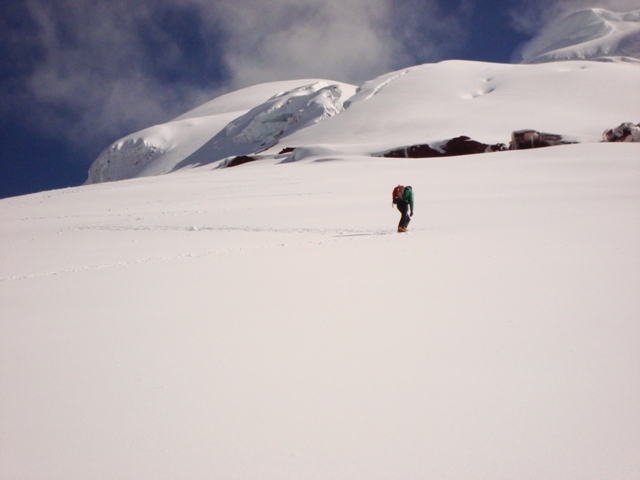
A climber on 5,897 m (19,400 ft) Cotopaxi, said to be the world's highest active volcano, ascends a glacier that has lost 30% of its surface area to global warming since 1976. With more than 24 peaks lofting over 4,200 m, the high Andes Mountains in Ecuador contribute to the country's diversity of habitats.
Larrea’s plan is to exploit Ecuador’s most valuable, but untapped asset: its biodiversity. “We cannot become a highly competitive country in terms of manufacturing and production in 10 or 20 years. It takes much more time.” The growing industry of ecotourism and cultural tourism is the answer he feels. He points to Costa Rica, which is an even smaller but more prosperous country, where 7% of the country’s employment is provided by tourism compared with 1.5% in Ecuador. In addition to its unmatched biodiversity, Ecuador has several other advantages for developing tourism. “We don’t’ have the violence of guerillas as in Columbia, or the violence that you can see in Peru or Mexico.” The opportunities for cultural tourism are also strong. The city of Quito, established by the Spanish in the 1500s in an area occupied by Indians for thousands of years, was designated a World Heritage Site by UNESCO in 1978, the first city in the world to receive such status.
Agreeing that ecotourism is part of the solution, Navarrete believes the problem is too big to be solved by tourism alone. Sustainable production of timber, fishing, and other industry will be necessary, but ecologists are against introducing foreign species, such as Monterrey pine and eucalyptus, into the rainforest for logging. “What about the ecological effects of the expanding pastures with cattle that are there now,” he asks? Development must be managed wisely, he says, just as with tourism. Between 2007 and 2010 UNESCO added the Galápagos Islands to the the list of World Heritage in Danger because of rampant tourism. Despite the pressures on it, satellites show that the Yasuní Park is still 90% undisturbed, according to Larrea.
What’s it worth?
To put the 3.6 billion dollar price tag of the Yasuní Initiative in perspective, consider that British Petroleum has set aside 37.2 billion to resolve litigation resulting from the 4.9 million barrels of oil that spewed from their damaged well in the Gulf of Mexico—ten times the amount requested to save the Yasuní Forest. Facebook expects to raise $5 billion in its IPO stock offering, and analysts put Facebook’s value at 125 billion in its business selling ads targeted to its users. The Defense Department has already spent $330 million, more than next year’s goal to preserve the Yasuní, to develop a more powerful bunker busting bomb to drop on Iran.
Will the plan succeed?
What assurance is there that oil companies will not exploit the oil someday, and what is there to keep President Correa or a future President from reneging on the promise after receiving the 3.6 billion? “I don’t think it is impossible, however we have binding international agreements signed with the UN, and there is a political reason and an economic difficulty to do so,” Larrea says.
“If any government in the future decides to exploit the oil they must first return the contribution,” he explains.
However, this may create a disincentive for companies to contribute to the initiative. In her announcement on December 20, Ivonne Baki, noted that “not a single contribution from Chevron,” had been received toward reaching the 100 million goal.”
Nevertheless, Larrea predicts that “It will be in the future increasingly difficult for governments to extract oil.” According to a recent poll, 83% of the Ecuadorian
population is against drilling for oil in Yasuní Park, despite the poverty they suffer and the economic benefit oil drilling would bring. In Germany, 120 thousand letters were sent to parliament by German citizen in support of the Yasuní Initiative. “We don’t expect the US government to help, given the problems we see in congress. This is not going to be discussed in the Senate, but it will be discussed in society,” Larrea says. “W
e want to work with private citizens, states, NGOs, to promote the initiative.” The Initiative has begun accepting tax-deductable donations from private citizens through its website
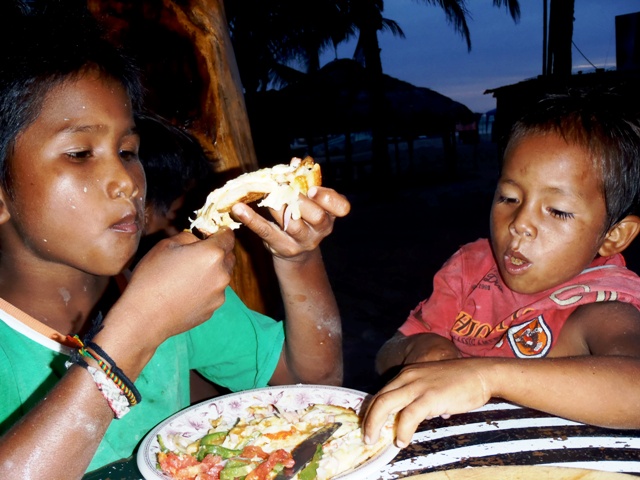
Poverty drives the destruction of the Yasuní rainforest. One third of Ecuador's children are malnourished; 60% in indigenous populations. It is not uncommon for diners to have hungry children approach their table, eyeing their meal like ravenous puppies. Here the children gratefully accept the tourist's generosity and devour the meal. Courtesy Clay Meier
Will the initiative succeed? “I think so,” Larrea says. “We have been successful, particularly in making the Yasuní Park an issue world-wide. This already is a very important success.” Until recently, almost no one knew of the Yasuní Park, he observes. A slight smile of pride surfaces momentarily on the professor’s face. “It is impossible to predict the future, but success doesn’t necessarily mean that there will not be drilling in the future,” he says despite his concerted effort to stop it. Awareness has been raised internationally to the problems of conservation in developing countries, and this has brought recognition that the costs, and the losses, are shared globally.
As if solving a complex multivariate equation, the enormously complex problem entangling ecological, economic, social, and geopolitical factors has been reduced to one simple solution: 3.6 billion. Now that the Initiative has sidestepped impediments imposed by governments and corporations, every citizen of the US and Europe can act independently to save the Yasuní through a website donation if they so choose. Call it a “Scheherazade solution,” but if the world calls the Ecuadorian President on his bet, the destruction the Yasuní rainforest can be saved from destruction for one more year, and then another, and possibly indefinitely.
******”When you have all your needs solved you can buy a bigger house and you have a garden. The garden for us is Yasuní National Park. When you don’t have [wealth] you have to live in a small apartment without a garden. In Europe and the US there are big national parks because the basic problems of poverty are not present.” Professor Hugo Navarrete.****
Please see the original post of this story on my Scientific American Blog. Several more photographs are included and the figure captions provide additional information. http://blogs.scientificamerican.com/guest-blog/2012/03/17/drilling-for-oil-in-eden-initiative-to-save-amazon-rainforest-in-ecuador-is-uncertain/
